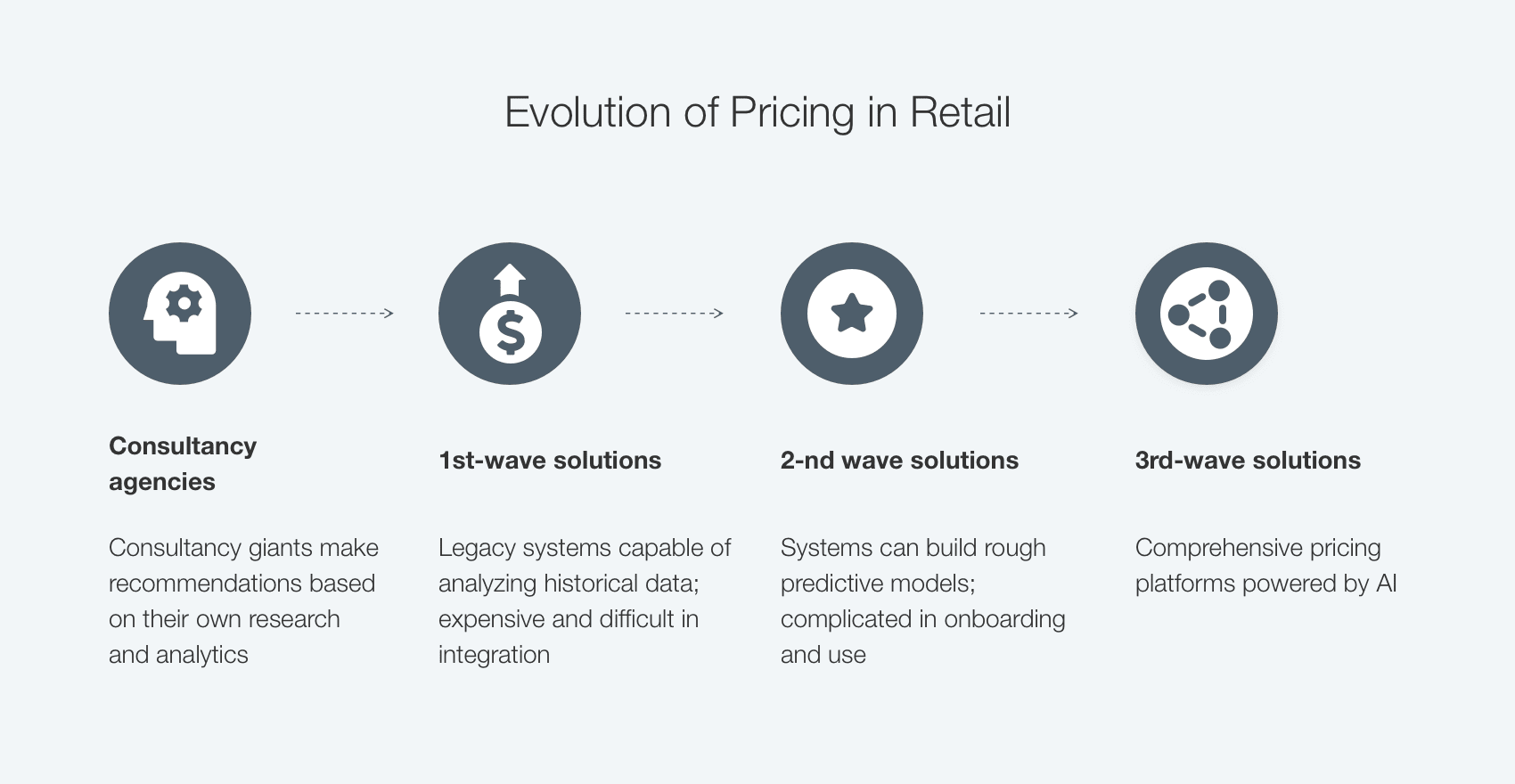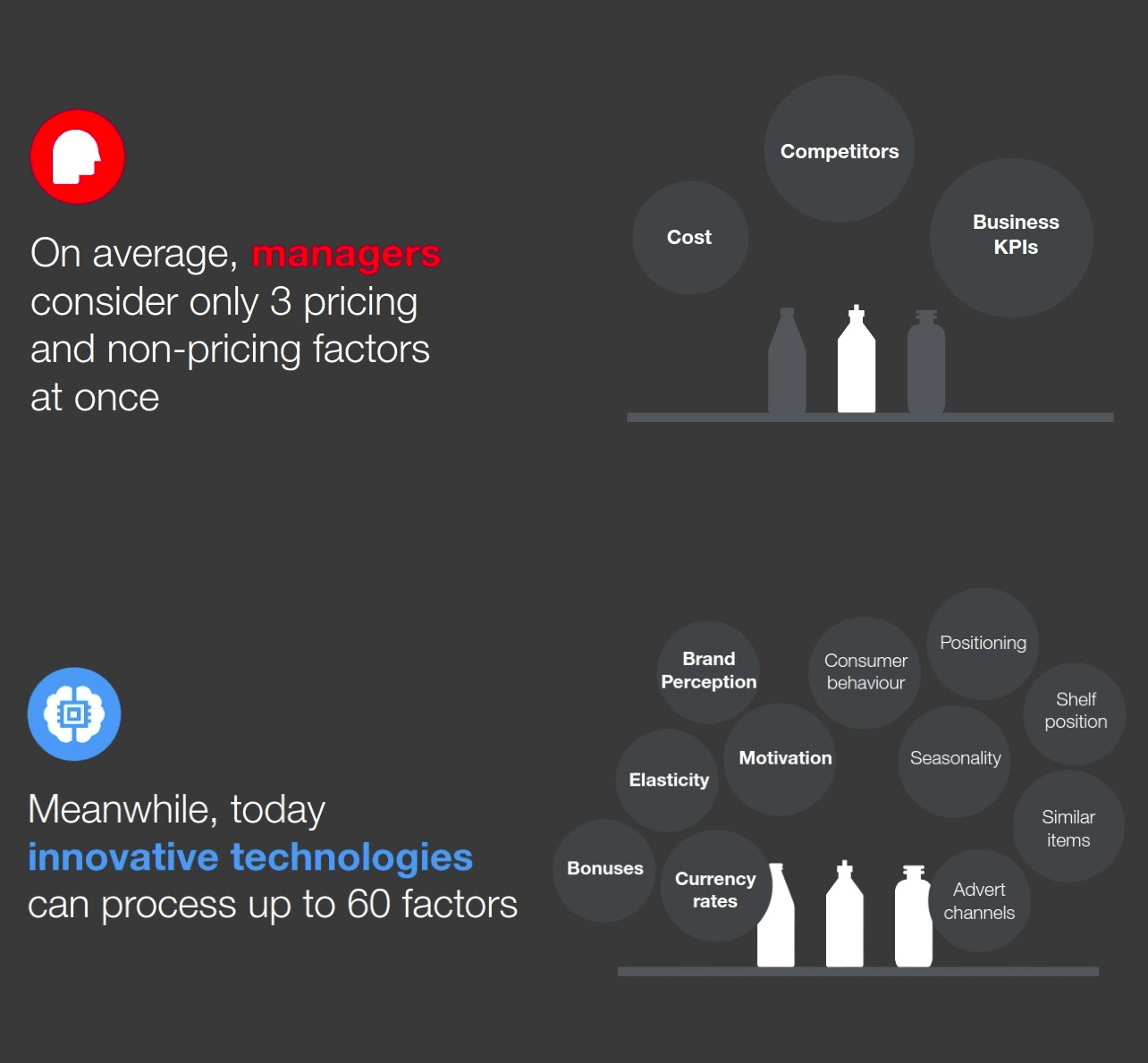Dynamic Pricing: Comprehensive A-Z Guide
Explore every single aspect that the business might face while dealing with dynamic pricing.
Why dynamic pricing is a must
Global economic turbulence provoked by the COVID-19 outbreak forced many retailers to undertake a panic-induced price setting. The latter means disregarding the long-term effects of changing consumer behavior and poor if any strategic forecasting. That's true: unexpected changes and new trends make it harder to build sustainable dynamic-response pricing models. But it doesn't mean that dynamic pricing is something retailers would disregard in the post-COVID world. In contrast, building complex dynamic pricing solutions is essential to be a market leader of tomorrow.
In which cases dynamic pricing is inevitable, what kind of companies are already using dynamic-response models, what is the role of dynamic pricing in yield or revenue management, how dynamic pricing works or what is the role of advanced software. Find answers to these and dozens of other questions in this ultimate guide.
What is dynamic pricing?
Dynamic pricing implies setting diversified prices targeting various groups of shoppers using the analytics at the junction of marketing trends, demand fluctuations, customer behavior, purchasing power, and other factors. As you might have noticed, the correlation between price and demand is the major idea behind the dynamic pricing. Dynamic price can be calculated using the formula:

P in the formula marks the price while d(p) stands for a demand function
Dynamic or demand-based pricing is one of the most sustainable approaches to drive sales and increase margin and revenue in the long-term period. The effectiveness of dynamic pricing stems mainly from the fact that an entire assortment is considered as integrity and priced coherently. What it means is that every single product is priced in regard to the product’s own role, roles of other products on shelf, and seller’s market positioning.
Want to know more about demand-based pricing? Find everything you might need by reading the article below
Dynamic pricing in yield and revenue management

Dynamic pricing is an essential element underlying effective yield and revenue management techniques. Before explaining how it works, let’s first make a distinction between the two terms.
Both yield and revenue management are aimed at maximizing revenue. The difference is that revenue management usually considers more factors compared to yield management concepts. For example, in case of bus transportations, revenue management would imply calculating the supplementing costs and ancillary revenue while yield management would be limited to rather general questions like how many bus seats should be allocated within every price segment?
Dynamic pricing represents a crucial means to reach the goals of both yield and revenue management. The reason is that pricing remains a crucial capability used to maximize profit and revenue across the businesses of all types. Read the article below to find out the other proven ways of increasing revenue.
Dynamic pricing and marketing
Dynamic pricing is a complex phenomenon built at the junction of many business activities and disciplines, including marketing. A company’s marketing strategy impacts directly the demand while the latter is a core factor in dynamic pricing.
What it means is that sustainable demand-based pricing is hardly possible without the effective, proper, and timely marketing initiatives undertaken by the business. This fact also explains why the long-term positive impact of dynamic pricing implementation could also serve as a KPI to mark the effectiveness of the marketing strategy.
Dynamic pricing for online and omnichannel inventories

One of the most largely cultivated myths associated with dynamic pricing implies that this approach has a limited scope of practical application. Being more precisely, dynamic pricing is often considered only within the context of brick-and-mortar sales. Indeed, brick-and-mortar stores were historically the first to implement dynamic pricing. But it doesn’t mean that the concept cannot be applied in online and omnichannel inventories.
In online and e-commerce, dynamic pricing has even greater potential compared to a standing alone brick-and-mortar model. The reason is that online businesses often have a more diverse and complex dataset than offline sellers. And that means online sellers can benefit from using top-notch multifactor algorithms analyzing transaction data, pricing data, promo history, inventory data, seasonality, weather, and a plethora of other factors. Undoubtedly, a dynamic pricing engine using such an algorithm is capable ofgenerating exceptionally accurate and comprehensive recommendations.
The same notion is applicable to omnichannel inventories. But there is no better proof than a real-life example. Amazon is probably the most convincing case illustrating the potential of dynamic pricing for both online and omnichannel inventories. The ultimate success of Amazon stems from the synchronization of e-commerce data, pricing, and inventory management.
History of dynamic pricing

Dynamic pricing is powered by advanced technology. That’s why speaking of the dynamic pricing history, we should consider it within the broader context of retail history and the evolution of pricing technology.
In general, the three historical waves of pricing technology solutions are distinguished. The emergence of dynamic pricing, as we know it today, should be linked with an emergence of third-wave pricing solutions in the mid-2010s.
The third-wave tech solutions enabled retailers of all types to implement automated and data-driven demand-based pricing. This means that the retail giants, like mentioned above Amazon, are no longer possessing a monopoly on dynamic pricing solutions.
Which companies use dynamic pricing?

There are thousands of companies across the regions and industries implementing a dynamic pricing approach. As we’ve mentioned above, train, railway, airlines, and other transportation companies were the pioneers in implementing dynamic pricing.
The businesses working with traveling and tourism are also extensively using dynamic pricing. These include hotel businesses, vacation and rental bookings. Dynamic pricing is also used by restaurants, taxi services, like Uber, and other logistics firms.
Dynamic pricing in airlines and railway business
Dynamic pricing is used across many industries besides retail. Airline and rail companies are fairly considered to be the pioneers in revenue and yield management. These industries were also the first to implement early dynamic pricing solutions.
What is dynamic award pricing (airlines)?
Dynamic award pricing is used by the airlines companies to increase the demand and promote the less popular routes among the travelers. Dynamic award pricing enables consumers to get cheaper award fares on either less sought-after routes or during the low travel season.
What is dynamic fare pricing (railways)?
Dynamic fare pricing implies charging the dynamic fare components i.e. part of the price which can be increased within a particular booking. Usually dynamic fare pricing is applied to the highly demanded bookings made in advance.
How does dynamic pricing algorithm work?

The third-wave dynamic pricing solutions are powered by the combination of AI and ML technology. Importantly, in contrast to traditional pricing, the dynamic approach gives almost unlimited capabilities in terms of the scalability of pricing decisions. For retailers, it means shifting from SKU-based to portfolio-level pricing in which all sorts of cross-dependencies within the assortment range are considered.
Most dynamic pricing engines use historical sales data based to estimate the demand function. Here is a typical workflow of a dynamic pricing algorithm:
- Historical data on price points and demand on particular products is consumed by the engine to be processed using the dynamic pricing algorithm.
- The demand function is built based on identified dependencies.
- The state-of-the-art math processes dozens of pricing and non-pricing factors to generate optimal prices.
- After the recommended prices are applied, the algorithm goes through the cycle again taking into account the latest repricing results.
If you want to learn more about dynamic pricing algorithm read the Ultimate Guide on Dynamic Pricing Algorithms in 2020
Dynamic pricing and machine learning
Machine learning remains the dominating technology used across industries to make accurate predictions of customers’ reaction to particular prices which are then used to forecast the demand.
How to choose dynamic pricing model

The choice of a dynamic pricing model is merely a choice of technology blend that would suit the needs of the business in the most appropriate and relevant way.
There are dozens of either ML or AI-driven solutions capable of processing big data with the last-gen deep learning neural network. Preferring one solution to another depends on the goals and constraints of each business. Another important factor is the portfolio target prioritized by a retailer. Sales volume, margin rate, revenue, or profit are examples of such targets.
Why is dynamic pricing important
There are dozens of factors impacting the demand for a particular product. Just one example: researches show that British people spend on average £258 more each year buying branded products over unbranded ones. And brand positioning is only one of many other factors shaping the demand. The point is: being aware of the demand, the business can maximize the revenue while giving customers what they want.
Now, let’s look at another fact: pricing remains a core capability while building a unique shopping experience. And dynamic pricing is an approach to manage price and demand as integrity. That’s why it’s importance is crucial across the industries.
When should business use dynamic pricing strategy?

The more fluctuating demand for a particular product or service is, the more relevant is the use of dynamic pricing strategy.
Another important factor is the business maturity of a company. To implement an advanced dynamic pricing algorithm, the business needs to have historical sales data and a team of dedicated professionals ready to adapt new technologies.
What are the benefits of dynamic pricing?
More and more companies across the globe start using dynamic pricing algorithms to craft an optimal value offering for customers. And there are good reasons for it:
- Dynamic pricing is a powerful means of boosting sales volume
- Dynamic pricing remains the most sustainable approach in terms of generating long-term revenue and profit uplift
- Advanced dynamic pricing relies on accurate forecasts reinforcing the long-term strategic planning by the business
- Adopting dynamic pricing technology helps to gain insights into consumer behavior which means an additional advantage over the rivals
What are the disadvantages of dynamic pricing?
At the same time, there are also particular challenges associated with dynamic pricing. Here are some cons associated with the approach:
- Abrupt implementation of dynamic pricing may discourage some customers as people, in general, prefer fixed prices
- Applying dynamic pricing might be less secure during crises or force majeure with unpredictable demand fluctuations
- Implementation of advanced dynamic pricing is a tech-savvy process requiring substantial resources
- For certain types of SKU, dynamic approach is almost inapplicable (e.g. old stock products)
Dynamic pricing as a personalization driver

Before speaking of dynamic pricing as a personalization driver, let’s make an important distinction. Here it is: dynamic pricing is not price discrimnation. Yes, the latter is also based on demand trends, but dynamic pricing aims at giving customers what they want while at a just price.
Dynamic pricing is a powerful means to gain insights into consumer behavior and that’s how the approach may serve a personalization driver.
So, in contrast to price discrimination, dynamic pricing is not only ethical but also mutually beneficial as it represents a win-win for both buyer and seller.
Reach business goals with dynamic pricing engine
Optimal value offering
Advanced pricing engines can help business to survive dynamic pricing competition in e-commerce. In particular, there is no better means to win the competition other than building a unique and highly personalized shopping experience at the junction of market trends, demand fluctuations, consumer behavior trends, and shoppers purchasing power.
Elasticity-based pricing for entire portfolio
Adopting dynamic pricing software enables the business to benefit from a goal-driven and elasticity-based pricing for the entire portfolio at any level from specific categories and stores to countries and world regions.
Dynamic pricing case study
Facts and numbers are better than words. Find how an omnichannel Eastern European consumer electronics retailer with $500 million in annual turnover managed to maximize revenue without losing profit margins, save time for negotiations with suppliers, and switch from reactive to proactive pricing using a dynamic pricing tool.
Dynamic pricing 101: learning course
Want to upgrade your skills and knowledge to become a dynamic pricing pro? Then, dynamic pricing learning course is exactly what you need.
How Competera helps to implement all of this?
At Competera, we consider every project as a retailer's journey to optimal pricing. No matter what solution lies at your first step, you get dedicated solution and pricing architects, Competera platform with the right tools to address your current issues. Moreover, our proof of concept model allows you to measure if Competera’s dynamic pricing technology is right for you before full deployment of the system.
Want to see what Competera can do for you?
Get your personal business offer






